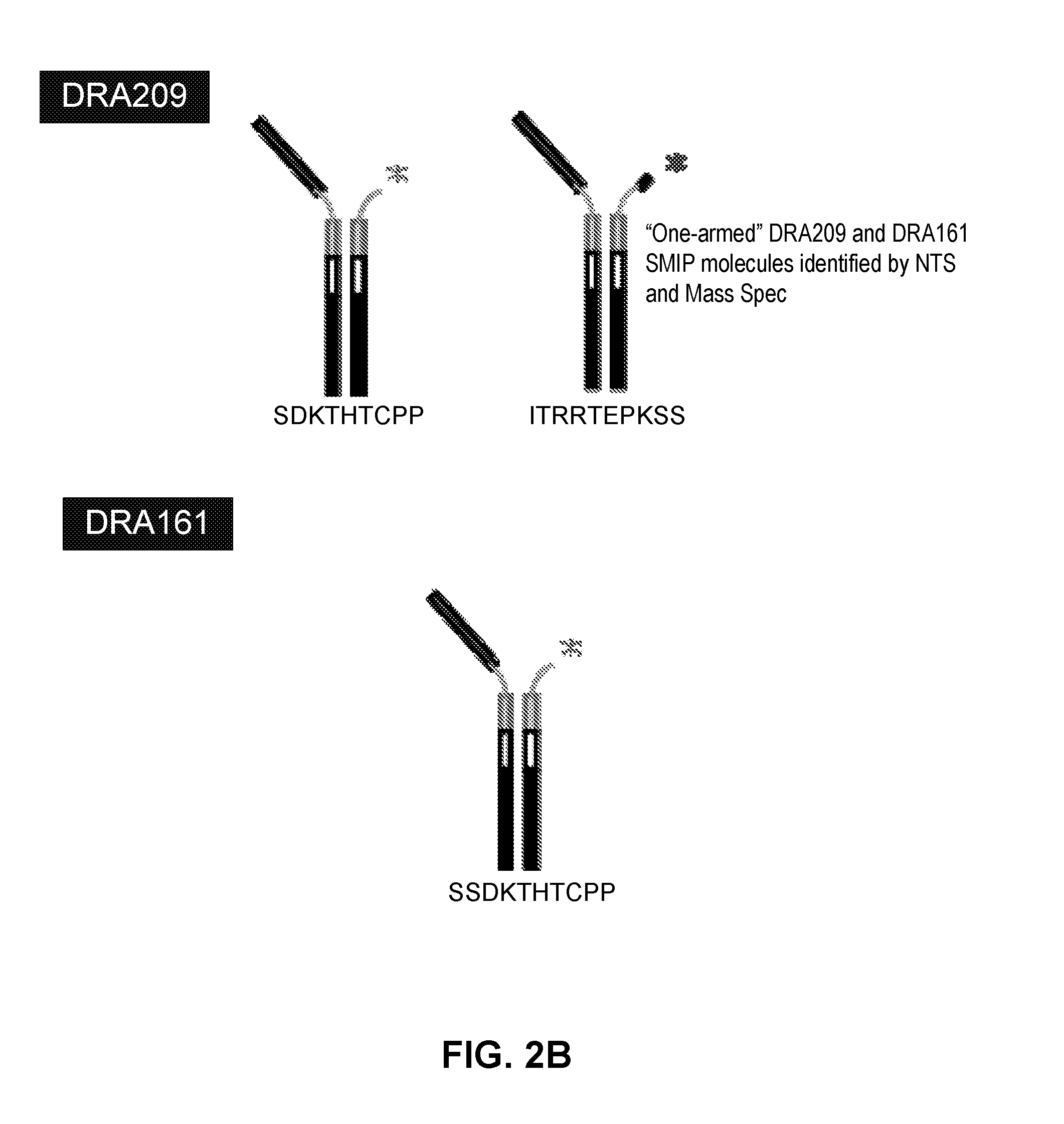Cd3 binding polypeptides
a cd3 and polypeptide technology, applied in the field of monospecific and multispecific protein therapeutics, can solve the problems of limited use, limited clinical use of okt3 in transplantation, extension of use, etc., and achieve the effect of reducing the isoelectric point (pi) of the binding domain and reducing the risk of immunogenicity
- Summary
- Abstract
- Description
- Claims
- Application Information
AI Technical Summary
Benefits of technology
Problems solved by technology
Method used
Image
Examples
example 1
Design and Construction of Anti-CD3 SMIP Molecules with Reduced Theoretical pI
[0230]L1, L2, H1, H2 and H3 (see FIGS. 3 & 4) are heavy and light chains of humanized Cris-7 that were previously constructed and analyzed for binding and activity. H3L1 was used to make SMIP DRA209 (SEQ ID NOs: 3 and 4; IgG4 AA ADCC-CDC null Fc) and SMIP DRA161 (IgG4 AA N297A Fc). Although these constructs exhibit improved characteristics over OKT3 and other anti-CD3 therapeutics in the prior art, the constructs exhibit significantly shorter half-life, higher theoretical pI (see FIG. 1) and “clipping” at the binding domain or prehinge region when expressed in CHO cells (see FIGS. 2A and 2B) as compared to other SMIP molecules.
[0231]Anti-CD3 pI variants were designed to reduce the pI of the binding domain and / or prehinge region. To make the anti-CD3 pI variants, new heavy and light chains (L3, L4, H4, H5, and H6) were ordered and synthesized by Blue Heron. See Table 3 and FIGS. 3 and 4.
TABLE 3CD3 Variable ...
example 2
Anti-CD3 SMIP Molecules Bind T-Cells
[0246]Human peripheral blood mononuclear cells (PBMC) were isolated from fresh whole blood using standard density gradient centrifugation and washed three times in PBS with 0.2% BSA. Cells were plated in 96-well plates U-bottom plates at 200,000 PBMCs / well and labeled with 50 ul of antibodies at the nM concentrations as indicated in FIG. 12 for 30 min on ice. Plates were washed three times and labeled for 30 min with 50 ul of an antibody cocktail containing optimal concentrations of anti-CD5-APC plus F(ab′)2 goat anti-hu IgG Fc-PE. Plates were washed three times and fixed in 120 ul of 1% paraformaldehyde in PBS, at 4 C overnight. All antibody incubations and washes were performed on ice, with cold PBS, 0.2% BSA, 2 nM EDTA. Samples were analyzed by flow cytometry using a BD LSRII analyzer. Sixty microliters were collected from each well. Collected samples were analyzed using Flowjo software by gating on T-cells (FCS vs SSC, CD5+ cells). The mean fl...
example 3
Anti-CD3 SMIP Molecules with Reduced pI Express Better in Cho Cells
[0247]Size Exclusion Chromatography:
[0248]Size exclusion chromatography was used to assess the high-molecular weight aggregate content of purified proteins. The HPLC system was an Agilent 1200 series equipped with a quaternary pump, solvent degasser, DAD, and temperature-controlled autosampler. A Tosoh TSKgel G3000SWxl column equilibrated in a running buffer of 200 mM potassium phosphate and 250 mM potassium chloride at pH 7.2 was used for chromatographic separation. Solvent flow rate was 1 mL / min and sample injection mass was 50 μg, Column effluent was monitored with the Agilent DAD detector at a wavelength of 280 nm.
[0249]SDS-PAGE:
[0250]Denaturing sodium dodecyl sulfate polyacrylamide gel electrophoresis (SDS-PAGE) was used to assess the integrity of purified proteins. Samples were prepared with Novex sample buffer (Invitrogen) and heated at 85° C. for 3 minutes to ensure full denaturation prior to loading into 4-2...
PUM
| Property | Measurement | Unit |
|---|---|---|
| equilibrium dissociation constant | aaaaa | aaaaa |
| length | aaaaa | aaaaa |
| electrical potential | aaaaa | aaaaa |
Abstract
Description
Claims
Application Information
 Login to View More
Login to View More - R&D
- Intellectual Property
- Life Sciences
- Materials
- Tech Scout
- Unparalleled Data Quality
- Higher Quality Content
- 60% Fewer Hallucinations
Browse by: Latest US Patents, China's latest patents, Technical Efficacy Thesaurus, Application Domain, Technology Topic, Popular Technical Reports.
© 2025 PatSnap. All rights reserved.Legal|Privacy policy|Modern Slavery Act Transparency Statement|Sitemap|About US| Contact US: help@patsnap.com



